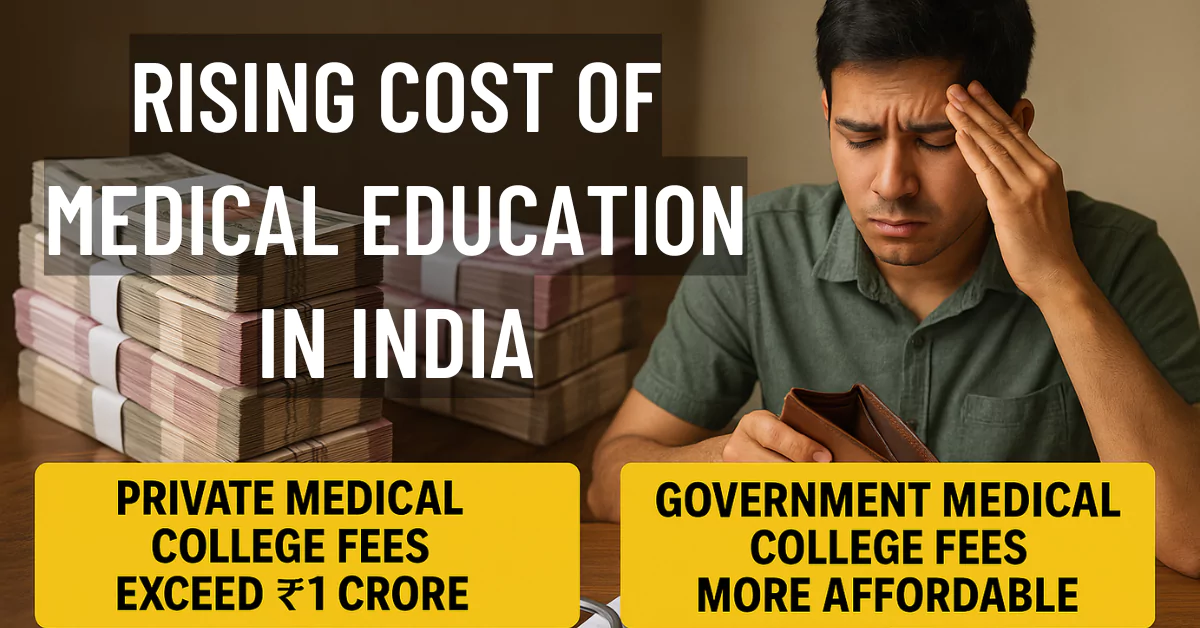What You Will Know!
- MBBS fees in top private colleges now exceed ₹1 crore
- The shocking fee gap between government and private medical colleges
- Why the NMC’s 50% fee regulation is a game-changer (and why it’s stuck)
- Landmark Supreme Court cases like T.M.A. Pai and Inamdar that affect fee control
- Cross-subsidisation and the financial struggles of medical families
- The battle between affordability vs autonomy in medical education
The cost of medical education in India has seen an unprecedented rise over the past decade. Private medical college fees now exceed ₹1 crore for an MBBS degree. While the government medical colleges charge only a few thousand to at most a lakh rupees per year. This widening cost gap puts immense financial burden on students and families, especially those from economically weaker sections.
To address affordability, the National Medical Commission (NMC), India’s apex medical education regulator, introduced NMC Fee Guidelines under the NMC Act of 2019. These guidelines mandate that 50% of seats in private and deemed medical colleges should have fees at par with government colleges.
In practice, however, these regulations have not been fully implemented. Private medical institutions have strongly resisted the fee caps, leading to legal battles and halting enforcement.
This article explores the trends in medical education costs, the socio-economic impact of rising fees, the provisions of the NMC Act of 2019 on fee regulation, and the reasons behind the government’s struggle to enforce these norms amid opposition from private colleges.
Rising Medical Education Costs
Medical college fees in India have surged dramatically in the last decade. Private institutions, in particular, have hiked tuition manyfold, citing high infrastructure and operational costs and ever-increasing demand for medical seats.
For example, in Tamil Nadu, deemed universities’ MBBS fees jumped by ~200% since 2015, from around ₹10 lakh to as high as ₹30-31 lakh per year by 2025. Total fees for a 4.5-year MBBS program at elite private colleges now commonly reach ₹1-1.5 crore.
By contrast, government colleges often charge only ₹5,000-₹50,000 per year, and prestigious institutions like AIIMS Delhi charge as little as ₹1,600 annually.
Costliest MBBS Colleges in India
These top institutes have crossed the ₹1 crore mark for the full 4.5-year MBBS course, with Sree Balaji Medical College leading as the highest at ₹30.5 lakhs annually.
Note: NRI quota seats in these colleges can cost ₹2–3 crore, but SBMCH charges ₹1.6 crore even for general quota management seats.
Miscellaneous charges like hostel, lab, and library fees can add ₹2-3 lakh per year. Annual tuition increases of 2-3% further compound the cost.
India had around 85,000 MBBS seats in 2022; by 2025, that number grew to over 1.18 lakh across 780 colleges, largely due to private sector expansion. Despite increased seats, fees remain high due to inelastic demand.
Economic and Social Impacts of Rising Medical Education Costs
High medical education costs make the profession inaccessible to lower-income and rural students.
In 2008, only 4.27% of MBBS entrants in Punjab came from rural backgrounds despite a 62% rural population share.
Fee hikes exacerbate the exclusion of marginalised groups
Many families mortgage property or take large loans for private MBBS seats. Post-graduation, doctors face debt burdens with modest starting salaries (~₹40,000/month), remaining financially dependent.
Rising costs also prevent PG specialisation unless students secure a government seat. Consequently, many Indians study medicine abroad, where fees are lower (₹25-35 lakh) compared to Indian private colleges (₹1–1.5 crore).
Approximately 75% of students who miss government seats either go abroad or to expensive private colleges. This represents a brain drain and economic outflow.
Cost pressures influence practice choices
Graduates opt for lucrative urban/corporate jobs or foreign placements to recover investments, worsening rural healthcare access. Medical education inflation far exceeds general inflation.
According to an economics professor, an MBBS costing ₹50 lakh in 2020 could cost ₹80 lakh by 2030. Public pressure has mounted for regulation, with student protests and litigation demanding affordable education.
The NMC Act 2019 and Fee Regulation Provisions
The NMC Act, 2019, replaced the Medical Council of India and empowered the National Medical Commission to regulate fees for 50% of seats in private/deemed colleges under Section 10(1)(i).
The idea: merit should not be denied due to high fees; education must follow a not-for-profit ethos.
After consultations, NMC issued fee guidelines on 29 Dec 2021, circulated on 3 Feb 2022. Key points:
- 50% of seats in private colleges must charge fees equal to those in government colleges.
- First, seats under the state quota; then additional students (in order of merit) until 50% covered.
- All admissions continue through NEET.
- No capitation fees or profiteering allowed.
- Fee must reflect actual costs (salaries, depreciation, utilities, etc.) with 6-15% development margin.
- Colleges must submit audited accounts, maintain transparency, and follow Ind AS 108 norms.
State FRAs were to work with NMC to ensure implementation. PM Modi endorsed the policy in February 2022. Bihar attempted unsuccessfully to implement it in the 2023 counselling, which it finally succeeded in 2025, when Bihar became the first state in India where a private MBBS college implemented the 50% fee rule.
Why NMC’s Fee Guidelines Are Not Fully Implemented
Implementation has been poor. Key reasons:
Legal Challenges
- Education Promotion Society for India (EPSI) and AHSI filed cases in the High Courts and the Supreme Court, terming the order unconstitutional and infringing on Article 19(1)(g).
- Courts like Kerala and Madhya Pradesh granted stays. The matter is sub judice, pending SC verdict.
Constitutional Issues
- Citing T.M.A. Pai (2002) and Inamdar (2005), private colleges argue that fee caps violate their right to manage institutions.
- They argue NMC cannot impose binding fee caps, only advise state FRAs.
| T.M.A. Pai Foundation (2002) and P.A. Inamdar (2005) Case | The T.M.A. Pai Foundation (2002) and P.A. Inamdar (2005) cases are landmark Supreme Court judgments that defined the rights of minority educational institutions in India under Article 30 of the Constitution. In the T.M.A. Pai case, the Court held that minorities have the right to establish and administer educational institutions without undue government interference. The P.A. Inamdar case further clarified that the State cannot impose quotas on private unaided minority colleges, though regulation for merit and transparency is permissible. Together, these rulings uphold autonomy for minority institutions while ensuring fair access through merit-based admissions. |
Financial Viability
- Colleges claim that enforcing government-level fees on 50% seats leads to financial loss, reduced quality, or shifting the burden to remaining students (whose fees may double).
- NMC counters that many colleges are profitable and should operate within cost-plus norms.
State Reluctance
- States vary in approach. Kerala had existing agreements. Bihar tried enforcement in 2023 but faced a legal stay.
- Others, like Tamil Nadu, follow state FRA rates. The Centre is waiting for the SC decision before pushing enforcement.
Political Clout of Private Colleges
- Many are backed by powerful individuals.
- Medical education is a “profit-making business” for political and corporate leaders.
- This limits government enforcement to transparency notices rather than fee caps.
Private Medical Colleges’ Opposition: Case Studies and Arguments
- EPSI vs. NMC: EPSI filed in the Madras HC, arguing fee cap was illegal nationalisation. Stay granted for 2022 admissions.
- AHSI vs. NMC: Filed in the Supreme Court. Hearing delayed. Centre defended NMC. No final verdict yet.
- Kerala: The High Court ruled the 50% rule won’t override state agreements.
- Bihar: Implemented the rule in 2023, stayed after a challenge by Lord Buddha Koshi Medical College.
- Maharashtra: No implementation; FRA continues usual approvals. Deemed universities charge ₹20-30 lakh/year.
Arguments of Private Colleges
- Fee parity creates cross-subsidisation, deemed unconstitutional.
- Each college’s cost structure differs; a blanket cap is unfair.
- Existing state FRAs already regulate fees.
- Private colleges fill capacity gaps left by the government. Without fee flexibility, they may shut down or degrade quality.
- Capping half the seats may inflate the rest (management/NRI quota), making them unaffordable.
| What is Cross-subsidisation? | Cross-subsidisation is a pricing or financial strategy where the profit from one product, service, or group is used to support or subsidise the cost of another. “One group pays more so another group can pay less.” Examples: In many private medical colleges, MBBS seats under the NRI quota are priced much higher. The extra revenue from these high-paying seats is used to subsidise general category or merit-based seats. |
Students and civil society back NMC’s stance, demanding affordable education. The issue awaits Supreme Court clarity.
The cost of medical education in India has reached unsustainable levels for most families. NMC’s fee guidelines under the 2019 Act are a significant step towards affordability. However, resistance from private institutions and legal hurdles has hampered enforcement. A decisive Supreme Court verdict is needed to resolve the policy deadlock.
Going forward, the government may need to:
- Work with states and FRAs for gradual implementation.
- Support financially stressed private colleges.
- Audit institutional accounts for fee rationalisation.
- Expand public colleges to reduce reliance on private seats.
Ultimately, the dream of becoming a doctor should not depend on a family’s bank balance. Equitable access to medical education is crucial for building a just and inclusive healthcare system for India’s future.


